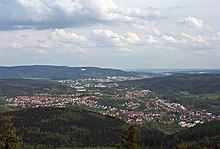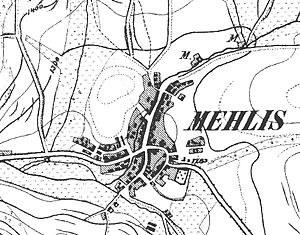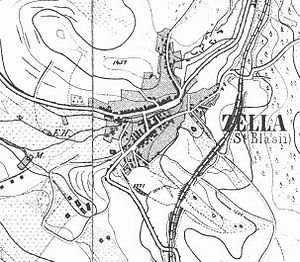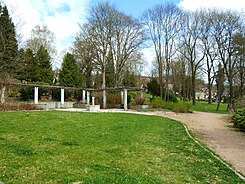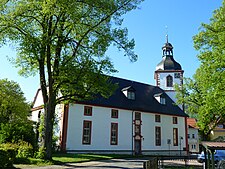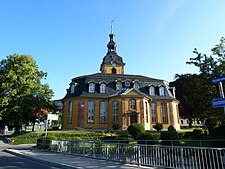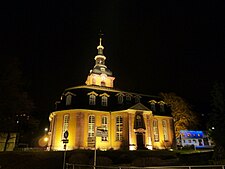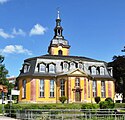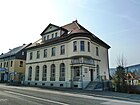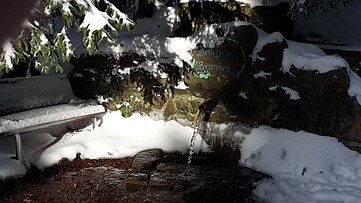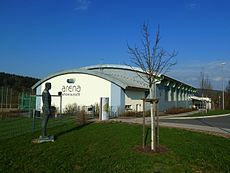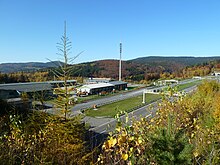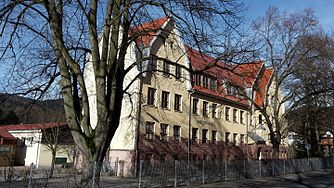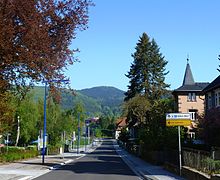Zella Mehlis
| coat of arms | Germany map | |
|---|---|---|

|
Coordinates: 50 ° 39 ′ N , 10 ° 40 ′ E |
|
| Basic data | ||
| State : | Thuringia | |
| County : | Schmalkalden-Meiningen | |
| Height : | 500 m above sea level NHN | |
| Area : | 52.99 km 2 | |
| Residents: | 12,727 (Dec. 31, 2019) | |
| Population density : | 240 inhabitants per km 2 | |
| Postal code : | 98544 | |
| Area code : | 03682 | |
| License plate : | SM, MGN | |
| Community key : | 16 0 66 092 | |
| LOCODE : | DE ZEM | |
| City structure: | Core city and a district | |
City administration address : |
Rathausstrasse 4 98544 Zella-Mehlis |
|
| Website : | ||
| Mayor : | Richard Rossel (independent) | |
| Location of the town of Zella-Mehlis in the district of Schmalkalden-Meiningen | ||
Zella-Mehlis is a small town in the district of Schmalkalden-Meiningen , in Thuringia , Germany , which was created in 1919 from the amalgamation of the communities Zella St. Blasii and Mehlis . Together with the independent city of Suhl , it forms a central center in the regional planning of the Free State of Thuringia with partial function of a regional center .
geography
Zella-Mehlis is located on the southern slope of the Thuringian Forest at an altitude of 450-580 m above sea level (urban area). The Sommerbachskopf as the highest mountain in the city limits has a height of 941 m. The closest major cities are Erfurt (44 km as the crow flies), Jena (71 km), Würzburg (110 km), Erlangen (120 km) and Nuremberg (137 km).
City structure
In addition to Zella-Mehlis, the district of Benshausen (with Ebertshausen ) belongs to the urban area.
Neighboring communities
Neighboring communities are Oberhof , Schwarza , Steinbach-Hallenberg and the independent city of Suhl .
dialect
Hennebergisch , a Main Franconian dialect, is spoken in Zella-Mehlis . The nearby Rennsteig acts as a linguistic border between Thuringia and the Franconian dialect space and situated in the linguistic geography , the natural border between Central and Southern Germany . The spoken to Mehlis' Mehlser Platt "it is only slightly different from the" Zeller Platt, "go for example Zellaer “Inn Waald” for a walk, the Mehlisers “inn Bährch (mountain)”.
history
In the past, the residents of the region used the favorable location of the Ruppberg to control and secure the traffic from southern Thuringia to the Oberhofer Pass. It is therefore assumed that a castle ( Schloss Ruprechtsburg ) stood for a short time on the Ruppberg near Zella-Mehlis as early as the middle of the 10th century . In the 11th century the noble free Timo von Nordeck sat on the mountain without mentioning a fortress. There are no remains of this castle to be seen. During the German Peasants' War in 1525, local farmers took part in the Bildhäuser Haufen near Meiningen .
Zella-Mehlis was founded on April 1, 1919 through the amalgamation of the town of Zella St. Blasii , which has been part of the community of Cella since the 12th century, and which has belonged to Saxony-Gotha since 1640 ( Black Forest Office , Zella Justice Office , Ohrdruf District Office ) and the ( since 1894 urban) community Mehlis formed. From 1920 to 1952 Zella-Mehlis belonged to the state of Thuringia , where it formed its own urban district until 1936 . Then it belonged to the district of Meiningen . This was due on the one hand to the fact that the city was located directly on the Prussian and the Kurhessian border and on the other hand because the city was one of the economically most important and richest communities in the state of Thuringia.
On March 15, 1920, five hundred armed workers moved to the neighboring town of Suhl to join forces with Suhl and other workers from the area to fight an 80-strong unit of Reichswehr soldiers as part of the Kapp Putsch . After several hours of fighting, the putschists were defeated by the workers, who then moved to Gotha via Oberhof and Ohrdruf in order to successfully support the resistance against the putschists there. A memorial in the former Mehlis cemetery commemorates the seven workers who lost their lives in the fighting.
After the First World War , the November Revolution and during the Weimar Republic , there was a strong labor movement in Zella-Mehlis . After the Reichswehr on behalf of President Friedrich Ebert in November 1923 forcibly removed the three-week-old workers' government in Thuringia made up of Social Democrats and Communists, the situation in Zella-Mehlis became more tense. A memorial in Heinrich-Heine-Straße still commemorates the sailor August Aschenbach who was shot by reactionary police in front of the “Wilhelmstal” inn . The inscription reads: In memory! August Aschenbach murdered by the reaction on January 1, 1924.
In the 1920s and 1930s there was also a local branch of the FAUD in Zella-Mehlis as well as the guild of liberal book lovers that emerged from it . The latter organized u. a. in 1932, a lecture event with the most dangerous woman in the world designated Emma Goldman .
At the beginning of the time of National Socialism and the persecution of citizens of other convictions and beliefs that followed, resistance immediately formed. Zella-Mehlis and the neighboring town of Suhl were called the “red cities” at that time. For the Reichstag election on March 5, 1933 , the two workers' parties, SPD and KPD , together received 4044 of 9213 votes. Resistance came primarily from the numerous workers' organizations, such as the Red Front Fighter League , the Red Sports Units , the Red Aid and especially from company organizations. Especially by workers from the large factories such as Mercedes-Bureau-Maschinengesellschaft mbH , with the married couple Hans and Else Raßmann and Fritz Wolf, who were connected to the Neubauer-Poser resistance group in Jena , played a special role. Two streets in the city bear their names. Several waves of arrests, which were also triggered by informers, brought Zella-Mehliser anti-fascists behind bars. Nevertheless, there was resistance to the National Socialists for almost the entire twelve years of Nazi rule, even across ideological boundaries. So z. B. from an illegal communist party group of about 60 people or from the Communist Youth Association, but also from social democrats , anarcho-syndicalists and free thinkers . The tasks of the self-organized units were collecting money and transporting them for organized resistance, producing and distributing leaflets, maintaining contact between the individual action groups, sabotage in the (armaments) factories and supporting families in need. The illegal KPD leadership in the Suhl sub-district, which had its headquarters in Zella-Mehlis, formed a center of resistance. It was not until the mass arrests of the Operation Grid that began in August 1944 that the resistance work of the illegal KPD sub-district leadership in Suhl also interrupted. Nikolaus Pfaff, a former member of the Reichstag, was one of the anti-fascists arrested at that time . Another street in Zella-Mehlis commemorates Karl Zink, who was executed in Berlin-Plötzensee in 1940 . The Marcel-Callo-Platz and a statue erected in his honor in the Christ-König-Kirche commemorate the French Catholic resistance fighter .
Of the 30 Jewish citizens who were deported to the extermination camps or who fled, only one woman survived. After the pogrom of November 9-10, 1938, six Jewish citizens were taken into “ protective custody ” and transferred to the Buchenwald concentration camp .
When the law for the prevention of genetically ill offspring came into force , 34 people in the Zella-Mehlis district were reported for forced sterilization . About 20 people were victims of the forced sterilization in the Meiningen State Hospital .
Between 1940 and 1945 a total of around 8,000 prisoners of war and men and women performing forced labor lived in Zella-Mehlis, who were deployed in more than 110 jobs. With the Walther-Waffenwerke Zella-Mehlis , which had carbines installed directly in the Buchenwald concentration camp, the Zella-Mehlis economy also benefited directly from the Nazi forced labor. 34 victims of forced labor (including Soviet victims from Benshausen ) rest in the old cemetery , which is now the city park . On March 8, 1945, there were 8,219 people in the largest forced labor camp, Beckerwiese , on Talstrasse, and in the prisoner-of-war camp opposite. A memorial plaque at the junction of Sommerauweg / Talstraße has been commemorating this camp since September 1, 2003.
Well over a thousand Rhinelander sought protection in Zella-Mehlis and in the Schleusingen district before the air raids during the Second World War . A whole train with evacuated old men, women and children from Liegnitz in Silesia ran into Zella-Mehlis in February 1945. On April 4, 1945, the US Army marched into Zella-Mehlis. The Red Army arrived on the morning of July 3, 1945 and replaced the Americans as planned. From then on, Zella-Mehlis was in the Soviet occupation zone and from October 1949 in the GDR .
After the districts were formed in the GDR, Zella-Mehlis was in the Suhl district . From 1967 until the district reform of Thuringia in 1994, Zella-Mehlis was the administrative seat of the Suhl-Land district .
On January 1, 2019, Benshausen became a district of Zella-Mehlis.
History of the district of Mehlis
The first documentary mention, dated 1250, can be found in Johann Georg Brückner's collection of various messages describing the church and school state in the Hertzogthum Gotha .
A part of Mehlis came to the Wettin Landgraves of Thuringia as early as 1357 through an area swap agreement of the Counts of Henneberg concerning the Provost Zella St. Blasii and subsequently came to the Office of the Black Forest . It also included the settlements of Stutzhaus , Lütsche , Arlesberg , Dörrberg , Gehlberg , the Oberen Hof and the Black Forest at the foot of the Black Forest Castle . The second complex of goods described in this contract in Mehlis remained in the county of Henneberg until 1583 and then went to the newly formed Saxon office of Hallenberg . The border situation that arose in this way remained in place until 1619, when the second goods complex was also ceded to the Black Forest Office as part of the Benshausen exchange agreement . In 1598, an encroachment by the new authorities on the traditional rights of governance escalated into a local riot. Almost all forest farmers were surrounded by mercenaries and locked up for three weeks in a building in the Georgenthal monastery. In penance, the remaining village population (craftsmen, carters, etc.) had to buy the prisoners free - ten guilders were to be paid for each man and five guilders for each woman. The main interest of the Hennebergers was the iron ore deposits in the Mehliser Flur. The first iron hammer is mentioned there as early as 1440, it formed the basis of existence for the iron processing industry in the forest settlements. More hammer and smelting works soon followed.
On March 27, 1894, Mehlis received city rights .
History of the district of Zella
Zella St. Blasii (Latin for: monastery cell consecrated to St. Blasius ) was founded in 1111 by Gebhard von Nordeck and subordinated to the Reinhardsbrunn monastery.
The place was until 1357 the seat of a provost and remained until the German Peasants' War in 1525 owned by the neighboring monastery Reinhardsbrunn. After 1525 a Lutheran pastor by the name of Hübner took care of the souls of the residents, the area of the Zella St. Blasii from then on belonged to various Ernestine duchies . For the Gotha dukes, the extensive forest ownership of the Reinhardsbrunn monastery was more important than the possible short-term profit from intensified mining. In 1534, the names of all families resident in the village are recorded in a list of taxes on inheritance and interest payments. The 86 names mentioned suggest a total population of around 400 people. The majority were deforested, her then land was partially offset by the traditional today Flurnamen be located. In terms of the settlement topography, Zella was structured as a street village , the gradually enlarged place is divided into the districts "Blasienzella" and "Schwarzzella" between 1535 and 1642. Miners and smelters, metalworkers, woodcutters, pitchers, resin paws, ash burners, Zeidler and charcoal burner also lived in the village. In 1624 iron ore mining in the Zella-Mehlis area was stopped. The pig iron was then obtained from Schmalkalden, later supplemented by deliveries from Westphalia and Saalfeld - evidenced by delivery lists from the carters.
On May 5, 1619, a major fire broke out at the Oberhammer in Zella, which quickly spread and cremated the church in Zella, the school and 50 houses, 40 stables and barns.
In 1642 Zella was designated the official seat of the Black Forest Office . The office building was built for the bailiff " behind the Zell on a hill called Cuntzenberg ... ". The first bailiff, Silchmüller, described his subjects as " so poor and overgrown ... " In 1645, Duke Ernst I of Saxe-Gotha raised the place to a market town . A visit scheduled in 1648 revealed 113 habitable, 11 burned-out and 32 empty houses.
From the 16th century onwards, the Zella, along with Schmalkalden and Suhl, developed into a main location for iron and steel processing in the Thuringian Forest.
In 1563, Count Georg Ernst von Henneberg established the guild statutes for locksmiths, gunsmiths, spurs and winch makers and designated Suhl as the seat of the Henneberg guild. A dispute soon broke out between the Zella and Suhl masters about the quality and usability of the manufactured articles, the Zella apprentices were not recognized by the Suhl masters. It was not until 1593 that the struggle for existence for the Zella master craftsmen ended with submission to the Suhl regulations, and the master craftsman examination always had to take place in Suhl.
In 1600 there was a report in Suhl about the establishment of a new gunsmith's shop in the Zella, in 1624 it was found that the Zella masters employed 10 to 15 journeymen and thus deprived their fellow masters of their wages and bread, in 1631 there was no delivery of guns to the Swedish garrison in Erfurt paid. In 1629 the Zellaer broke away from the Suhl guardianship and founded their own gunsmiths guild. During the Thirty Years' War, however, the handicraft was temporarily ruined by multiple looting and confiscation. In 1641 Valtin Schneider was charged high taxes for his devastated drill mill, but he did not oppose it. Between 1644 and 1648 the Gotha armory ordered several deliveries of muskets and pistols. The number of (locksmith) masters was 40 in Zella in 1652 and 19 in Mehlis. In the years 1659 to 1662 the Zella guild was awarded an annual production contingent of 1000 muskets as well as 200 pistols and other handguns.
In 1663 the state authorities allowed the construction of a Zainhammer and another drill mill. In 1666, small-caliber cannon barrels , known as small pieces of iron , were first manufactured in the Zella , but they had to be checked and sold in the city of Suhl.
Since 1707 cuirasses have also been made in the Zella, and these had to withstand a bullet test. Because of several "incidents", the arms dealers supplied by the Zella people are forced by the state authorities to set up a rifle trading company in order to prevent the gunsmiths from being cheated. From 1722 the delivery of charcoal was regulated, experiments with brown and hard coal are unfavorable. From 1729 it was no longer allowed to sell charcoal abroad (rule Schmalkalden).
A major fire destroyed numerous houses and workshops in 1762. In 1766, the state authority determined the distribution quotas of the annual forest areas for charcoal production and sales to the master craftsmen in a renewed wood regulation.
On the decree of Duke Ernst, the construction of a new state road from Gotha to Coburg across the Thuringian Forest began in 1831. The road improves transport connections and enables further economic development. In 1832 a vocational school for metalworkers was founded, it is only open on Sundays and must be attended by every apprentice.
The connection to the railway network with connections to Erfurt and Meiningen was created from 1881 to 1884.
The establishment in 1899 and the operation of the gunsmith Weihrauch in Zella-St. Blasii (Amtsstraße 24) is part of the local history.
Religions
The population of Zella and Mehlis turned away from Catholicism to the Lutheran creed at an early stage during the Reformation . The historic baroque churches and their parishes belong to the Evangelical Church in Central Germany .
In Zella-Mehlis there is still a church for the Roman Catholic Christians who belong to the diocese of Erfurt .
Population development
Development of the population:
|
1946 to 1984
|
1994 to 1998
|
1999 to 2003
|
2004 to 2008
|
2009 to 2013
|
since 2014
|
- Data source from 1994: Thuringian State Office for Statistics
1) October 29th
2) August 31st
politics
City council
The local elections on May 26, 2019 with a turnout of 60.2% led to the following distribution of votes and the 24 seats in the city council:
| Party / list | Share of votes | W / l% p | Seats | G / V |
| CDU | 20.3% | - 3.6 | 5 | - 1 |
| The left | 9.4% | - 10.6 | 2 | - 3 |
| SPD | 7.5% | - 1.1 | 2 | ± 0 |
| Free voters | 26.4% | - 21.1 | 6th | - 5th |
| AfD | 11.0% | + 11.0 | 3 | + 3 |
| Rennsteig citizens' initiative | 20.1% | + 20.1 | 5 | + 5 |
| Responsibility for Benshausen | 5.2% | + 5.2 | 1 | + 1 |
P / L = change compared to 2014 The newly selected lists have a dark background.
mayor
The full-time mayor Richard Rossel (independent) was elected on May 6, 2012 with 54.9% of the votes in the runoff election. On April 15, 2018, he was able to prevail in the mayoral election with 56.3% of the votes against Thomas Roth (BI Rennsteig).
coat of arms
Blazon : “Fourth of silver and blue; in 1 a growing nimbly gold-haired bishop in a red chasuble with a silver pallium , on it a black cross, and a red cloak with a red and silver miter , in the right hand a gold bishop's staff and in the left two crossed burning gold candles, in 2 an oblique right laid stretched silver crossbow, in 3 a crossed silver pair of mallets and irons, in 4 a growing nimbled gold-haired saint dressed in red with a white belt, holding a golden goblet in front of her chest in both hands pointing upwards . "
The coat of arms in the upper right part symbolizes the patron saint of Zella St. Blasii, St. Blaise and the crossbow as a symbol of the centuries-long weapon production. In the lower right part of the coat of arms the crossed mountain irons stand for the long tradition of mining , the fourth field shows St. Magdalena , the patron saint of Mehlis.
Town twinning
Since 1990, Zella-Mehlis has had a city partnership with Andernach in Rhineland-Palatinate and a city friendship with Gemünden am Main in Bavaria . A friendship treaty has been linking Zella-Mehlis with Saint-Martin-d'Hères in the French department of Isère since 1967 .
Culture and sights
Regular events
The most important of the annual festivals are the Walpurgis Night on April 30, which is the largest of its kind in southern Thuringia , and the city festival on the second weekend in September, which attracts over 15,000 visitors every year.
Museums
- Historic drop forge at Lubenbach (Technical Museum): The building, which originally had two water wheels, was built in 1850 as a sawmill. Later, a forge that had been in the area since 1843 took over the building. In 1918 it was converted into a drop forge. Today the property is a listed building .
- Today's city museum emerged from the Ducal Saxon, from 1920 Thuringian shelling establishment and also deals with the gunsmithing trade, which is important in the region .
- The Zella-Mehlis Sea Aquarium Adventure Park shows more than 4000 animals (around 200 species in over 60 aquariums and terrariums) on an exhibition area of 6650 m²; the facility has a crocodile house , a koi park and a shark tank .
- Local history museum Benshausen
Buildings
- The Evangelical Lutheran Church of St. Blasii in Zella was built between 1768 and 1774 and is one of the most important baroque central buildings in Thuringia.
In front of the church there is a small stele that commemorates the victims of the Anabaptist community that existed in Zella around 1530.
- As early as the 13th century, the place Mehlis received a chapel, which was replaced by the Magdalenenkirche in the 14th century. A lightning strike set the building on fire. The new building was also destroyed by flames. Today's Magdalenenkirche was consecrated on Palm Sunday in 1741 and still has the stone tower of the original church.
- With the construction of the A 71 , an outstanding traffic structure was built in the immediate vicinity of the city with the 7,916 m long Rennsteig tunnel , the longest motorway tunnel in Germany. Zella-Mehlis is located at its south portal.
- A waste incineration plant has been located in the south of the city since 2007. Its establishment was highly controversial, and the city administration also litigated against it.
- On the Lerchenberg there is a memorial for those who died in the First World War .
- In the city area, several stumbling blocks were laid in memory of Jewish fellow citizens. See also: List of stumbling blocks in Zella-Mehlis
landscape
Mehlis' local mountain is the 866 m high Ruppberg , known as a hiking destination and popular viewpoint , which can be reached via the county road to Oberschönau. The 882 m high Spitz'ge Berg is Zella's local mountain . The highest point in the city is the 941 m high Sommerbachskopf, a secondary peak of the Great Beerberg . The Rhön-Rennsteig-Radweg and Haseltal-Radweg lead through the village .
Sports
Sports facilities
The municipal sports facilities were renovated from 2007 to 2009 and a new sports and multi-purpose hall was completed in 2010 . The sports complex was named Arena Schöne Aussicht .
sports clubs
Traditionally, winter sports in Zella-Mehlis, as in the entire Thuringian Forest , play a prominent role. The clubs from Zella-Mehlis also benefit from the proximity to the Oberhof winter sports center . Above all, the athletes of the SC Motor Zella-Mehlis , who are particularly successful in the disciplines of cross-country skiing , biathlon and Nordic combined , gain fame beyond the borders of the city and the country .
Wrestling also has a great tradition in the city . The first team of the AV Jugendkraft / Concordia is currently wrestling in the Bayernliga Nord in cooperation with SV Jugendkraft 03 Albrechts (they form the South Thuringia combat community). TSV Zella-Mehlis with its 22 subdivisions is responsible for popular sports in the city . The club is the fifth largest sports club in Thuringia and the largest of its kind in the south of the Free State. The footballers of the TSV were merged with those of the WSG. The WSG Thuringian Forest Zella-Mehlis, whose first team is currently playing in the Season 3 regional class, was awarded the “Star of Sports” for its young talent.
Economy and Infrastructure
Overview
After the political change in 1989/1990 and the loss of large industrial companies, the Zella-Mehlis economy was subject to enormous structural change. Today the economic picture of the city is characterized by a large number of small and medium-sized businesses. Metal processing , the automotive supplier industry and traditional craft businesses play a special role . A total of around 1000 businesses are registered in the city today.
tourism
Zella-Mehlis is a state-approved resort . The tourist information is located in the town center. In terms of tourism, the place is characterized by hiking tourism in summer (approx. 60 km of hiking trails) and cross-country skiing in winter. Zella-Mehlis is home to the Zella-Mehlis Sea Aquarium Adventure Park , a sea aquarium , as well as the drop forge technical museum and the city museum Beschussanstalt .
Public infrastructure
Due to its former function as the district town of the Suhl-Land district, the public infrastructure of the city of Zella-Mehlis is better developed than in other communities of comparable size. The municipal hospital was closed on June 30, 2006, but the buildings now function as a supraregional medical center and nursing home. In Zella-Mehlis there is still a branch of the district office Schmalkalden-Meiningen and all elements of a tripartite school system. The Zella-Mehlis volunteer fire brigade has the status of a base fire brigade and, among other things, performs leading tasks in the district in the area of NBC defense . In the area of the industrial area "East" is the emergency center of the fire brigade and disaster control for the tunnel chain of the A 71 as well as the office of the motorway police station south. In addition, the road construction authority in Southwest Thuringia is based in Zella-Mehlis.
education
All elements of the tripartite school system exist in Zella-Mehlis . The two primary schools " Martin Luther " and " Friedrich Schiller " prepare students for secondary schools. The regular school "Lutherschule" and the grammar school " Heinrich Ehrhardt " still exist . There is also a vocational school in Zella-Mehlis in the "Ost" industrial park and the South Thuringia Education Center, a competence center for training and promoting disabled and disadvantaged young people. The Zella-Mehlis educational camp, a counterpart to the Christes educational camp, has been located on the Schwarzberg since 2007 . The aim of this unique facility is to support gifted children of primary school age and beyond.
Commercial areas
Zella-Mehlis has five designated industrial areas. The largest by far is the “Zella-Mehlis Ost” industrial and commercial area , directly on the A71. With an area of around 120 hectares, it is one of the largest in the district.
Trade and service
On the outskirts of the city, in the area of the “East” industrial area, a shopping center was built in the mid-1990s that is now called “A71-Center”. In December 2012, a new shopping center was opened in Talstrasse.
Public safety and fire protection
In the city there are two fire stations located in the districts of Zella-Mehlis and Benshausen. The location in Zella-Mehlis counts in Thuringia as a " base defense " with supra- local tasks (e.g. in case of disaster control). In the vicinity of the town hall there is also an ambulance station of the DRK district association Schmalkalden eV and in the same building a contact area officer (KOBB) of the Thuringian police .
traffic
Public transport
The Zella-Mehlis train station , located in the Zella district, is a railway junction. There branches off from the railway line Erfurt-Schweinfurt the branch line to Wernshausen (with onward connections to Werrabahn ) from. This also serves the Zella-Mehlis West stops in the Mehlis district and Benshausen in the district of the same name. The regional express Erfurt – Würzburg ( Mainfranken-Thuringia Express ) operated by DB Regio and Regio-Shuttles Erfurt– Meiningen operated by the Süd-Thüringen-Bahn run alternately on the main line every two hours , so that it runs between Erfurt and Grimmenthal a total of about one hourly. On the aforementioned branch line to Wernshausen via Schmalkalden , trains of the South Thuringia Railway run every hour on weekdays and every two hours on weekends.
Since the end of 2012 there have also been long-distance bus connections from MeinFernbus from Zella-Mehlis train station :
- Line 015 Berlin –Suhl / Zella-Mehlis– Würzburg - Heilbronn - Karlsruhe - Freiburg im Breisgau
- Line 029 Munich - Nuremberg - Bamberg - Coburg - Suhl / Zella-Mehlis - Erfurt - Nordhausen - Hanover - Hamburg
- Line 055 Leipzig –Suhl / Zella-Mehlis– Würzburg - Stuttgart - Karlsruhe - Offenburg
In addition, Zella-Mehlis has several intercity bus routes operated by Meininger Busbetriebe as well as lines B, H and I (city line Zella-Mehlis) operated by the Suhl / Zella-Mehlis municipal transport company. In 1989 a trolleybus line to the neighboring city of Suhl was supposed to go into operation in the city , but the project could not be implemented in times of political upheaval.
The nearest airports are Erfurt-Weimar (60 km) and Nuremberg (160 km).
Road traffic
Cell-Mehlis is connected to the connection points Suhl / cell-Mehlis and Oberhof directly to the A 71 Erfurt- Schweinfurt connected. The important state road 3247 Ohrdruf - Schleusingen (formerly B 247 ) also runs through the city. The B 280 Meiningen-Zella-Mehlis has lost its importance for national traffic because of the parallel motorway and has been repealed. In contrast, the section from Benshausen to Zella-Mehlis and continuing to the A 71 was renamed Bundesstraße 62 . After the expansion of existing country roads, the B 62 later continues from Benshausen via Steinbach-Hallenberg, Schmalkalden and Wernshausen to Barchfeld, where it will be connected to the existing B 62 in the direction of Bad Salzungen.
Personalities
Honorary citizen
- Theobald Buddeus (1816–1903), pastor and local chronicler
- Helmut Recknagel (* 1937), first German Olympic champion in ski jumping and world champion, started for the SC Motor Zella-Mehlis
sons and daughters of the town
- Johann Hartmann (1537–1607), printer and publisher
- Hieronymus Florentinus Quehl (1694–1739), composer and organist
- Johann Kaspar Friedrich Manso (1759–1826), school man, historian and philologist
- Valentin Sauerbrey (1804–1881) gunsmith in Basel
- Johann Heinrich Ehrhardt (1805–1883), locomotive builder, chief engineer for the Saxon railways
- Johann Peter Haseney (1812–1869), engraver, creator of the first German postage stamp "Schwarzer Einser"
- Gotthilf Albert Sterzing (1822–1889), First President of the German Rifle Federation
- Johann Heinrich Zang (1733–1811), composer
- Heinrich Ehrhardt (1840–1928), inventor and industrialist, founder a. a. the Rheinmetall and the Eisenach car factory
- Gustav Ehrhardt (1868–1945), son of Heinrich Ehrhardt, automobile pioneer, vehicle designer and motor sports enthusiast
- Otto Wahl (1904–1935), cross-country skier
- Karl Zink (1910–1940), communist resistance fighter
- Karl Heinz Lemmrich (1926–2018), engineer and politician, member of the Bundestag until 1988 (CSU)
- Kurt Hoppe (* 1936), right-wing extremist, Thuringian state chairman of the German party
- Uta Gerhardt (* 1938), sociologist, professor emeritus at Heidelberg University
- Nikolaus Henkel (* 1945), Germanist
- Michael Schumann (1946–2000), politician (SED, PDS), member of the People's Chamber, member of the Bundestag
- Gerhard Strate (* 1950), lawyer and criminal defense attorney.
- Peter König (* 1959), railroad worker and illustrator
- Thomas Michalowski (* 1962), soccer goalkeeper
- Manuela Oschmann (* 1965), cross-country skier
- Anja Kampe (* 1968), opera singer
- Oliver Doehring (* 1969), Comedian ( Der kleine Nils ),
Persons connected to Zella-Mehlis
- Nikolaus Pfaff (1892–1951), teacher and politician (KPD), died in Zella-Mehlis
- Marcel Callo (1921–1945), blessed of the Roman Catholic Church, after whom a square was named here
- Herbert Albrecht (1925–1997), wrestler from SC Motor Zella-Mehlis
- Horst Jäger (1928–2009), writer, teacher at the company school of VEB Robotron Elektronik Zella-Mehlis
- Helmut König (1934–2017), medalist
- Peter Lesser (* 1941), ski jumper from SC Motor Zella-Mehlis
- Horst Queck (* 1943), ski jumper from SC Motor Zella-Mehlis
- Reinhard Heß (1945–2007), ski jumping trainer in Zella-Mehlis, national trainer
- Fredi Albrecht (* 1947), wrestler and referee, attended the children's and youth sports school here
- Klaus-Peter Göpfert (* 1948), wrestler, attended the children's and sports school in Zella-Mehlis
- Rainer Schmidt (* 1948), ski jumper, overall winner of the Four Hills Tournament, lives in Zella-Mehlis
- Christoph Matschie (* 1961), politician, SPD chairman in Thuringia, parliamentary state secretary, received professional training with high school diploma as a mechanic in Zella-Mehlis
- Kati Wilhelm (* 1976), biathlete from SC Motor Zella-Mehlis
- Sebastian Haseney (* 1978), Nordic combined athlete from SC Motor Zella-Mehlis
- Franz Göring (* 1984), cross-country skier, lives in Zella-Mehlis
- Andi Langenhan (* 1984), luge rider from RRC Zella-Mehlis
- Frank Rommel (* 1984), skeleton pilot
- Carl Wilhelm Freund Walther (1858–1915), founder of Carl Walther GmbH
- Robert Wick (* 1984), biathlete from SC Motor Zella-Mehlis
- Thomas Wick (* 1991), cross-country skier from SC Motor Zella-Mehlis
- Tino Edelmann (* 1985), Nordic combined athlete from SC Motor Zella-Mehlis
Music groups from Zella-Mehlis
- XIV Dark Centuries (1994-), pagan metal band
Web links
- More information about the Thuringian shooting establishment in the specialist article at Monumente Online
- Author collective Zella-Mehlis (ed.): Fascist dictatorship - resistance struggle and persecution in Zella-Mehlis 1933 to 1945. 1st edition. January 2005; www.geschichte-zella-mehlis.de
Remarks
- ↑ Ruprechtsburg : Timo was married to Hildegard, widow of Count Poppo I. Count von Henneberg , who died in the battle of Mellrichstadt , who was also the daughter of Count Ludwig the Bearded . According to Timo's plans, the marriage should secure his dominion, consisting of a few settlements, against the rival Hennebergers and the Landgraves of Thuringia. Early historical remains of a rampart were found on the Ruppberg.
- ↑ First mention of Mehlis : The first mention of 841 is not documented. The year results from the assumption of a local researcher in the second half of the 20th century, who concluded from the first mentions of the other villages in the Grund der Lichtenau that Mehlis was also mentioned in 841. Based on this information, the 1150th anniversary was celebrated in 1991, which further solidified this unproven year as given.
- ↑ End of the division of Mehlis : Duke Ernst I of Saxony-Gotha finally negotiated the former Henneberg rights in Mehlis in 1661 as part of the division of the County of Henneberg from Saxony-Zeitz based on the Kahla Treaty , thus ending the centuries-old division of the town into two.
- ↑ First mention of Zella St. Blasii : Although the first mention documents from 1111 and 1112 belong to the Reinhardsbrunn forgeries, the content is considered scientifically recognized.
- ↑ Beginning of weapon production : Until 1563, cutting and stabbing weapons (swords, knives, halberds, spits) were mainly made in Zella and Mehlis, as well as crossbows and armor that were mainly brought to the trade fair city of Erfurt.
Individual evidence
- ^ Population of the municipalities from the Thuringian State Office for Statistics ( help on this ).
- ↑ University of Jena, Thuringian Dialect Research Unit ( Memento from March 9, 2018 in the Internet Archive ) viewed on June 30, 2018
- ↑ Michael Köhler: Thuringian castles and fortified prehistoric and early historical living spaces. Jenzig-Verlag Köhler, Jena 2001, ISBN 3-910141-43-9 , p. 216.
- ↑ Graesse , Benedict: Orbis latinus . Lexicon of Latin Geographical Names. Manual edition, 4th edition. Edited by Helmut Plechl, Braunschweig 1971, pp. 88 and 577.
- ↑ oocities.org (PDF; 381 kB).
- ↑ Hartmut Rübner : Freedom and bread. The Free Workers' Union of Germany. A study on the history of anarcho-syndicalism (= archive for social and cultural history. Vol. 5). Libertad-Verlag, Berlin et al. 1994, ISBN 3-922226-21-3 , pp. 202, 218, (At the same time: Bremen, University, diploma thesis, 1992: History and theory of anarcho-syndicalism in Germany. ).
- ↑ deu.anarchopedia.org ( Memento from August 27, 2011 in the Internet Archive ).
- ↑ a b c d geschichte-zella-mehlis.de
- ↑ Thuringian Association of the Persecuted of the Nazi Regime - Association of Antifascists and Study Group of German Resistance 1933–1945 (Ed.): Local history guide to sites of resistance and persecution 1933–1945. Volume 8: Thuringia. VAS - Verlag für Akademische Schriften, Frankfurt am Main 2003, ISBN 3-88864-343-0 , p. 263 ff.
- ↑ Thuringian Law and Ordinance Gazette No. 14/2018 p. 795 ff. , Accessed on January 21, 2019
- ^ Wolfgang Kahl : First mention of Thuringian towns and villages. A manual. 5th, improved and considerably enlarged edition. Rockstuhl, Bad Langensalza 2010, ISBN 978-3-86777-202-0 .
- ^ History of the city of Zella-Mehlis .
- ^ Peter Heckert: Steinbach under Hallenberg - History of a Hessian-Thuringian city. 1990.
- ^ The uprising of the Mehlis forest farmers in 1598 . In: Council of the district of Suhl (ed.): Suhl. City and country in the Thuringian Forest . Progress printer, Erfurt 1955, p. 93-94 .
- ↑ What the inheritance and interest lists of the Black Forest Office from 1499 to 1534 tell us about the life of forest farmers . In: Council of the district of Suhl (ed.): Suhl. City and country in the Thuringian Forest . Progress printer, Erfurt 1955, p. 93-94 .
- ↑ Harry Ansorg: Eight hundred years of weapons production in Zella-Mehlis . In: History and Museum Association Zella-Mehlis (ed.): Zella-Mehliser local history contributions . Issue 2. Heinrich-Jung Verlagsgesellschaft, Zella-Mehlis 1993, p. 8-13 .
- ^ History of the city of Zella-Mehlis .
- ↑ The mining and iron processing of Zella-Mehlis . In: Museum for Pre- and Early History Weimar (Ed.): Prehistory and local research . tape 15 . Self-published, Weimar 1978.
- ^ Herbert Bauer: Suhl a home book - city and country in the Thuringian Forest . Zella-Mehlis section. Erfurt 1955, pp. 34-35
- ^ Thuringian State Office for Statistics: 2014 municipal council elections - final result of Zella-Mehlis .
- ↑ CDU leaves feathers in runoff elections , insuedthueringen.de of May 6, 2012.
-
↑
Commons : Marine Museum Adventure Park - Collection of images, videos and audio files
- ↑ Career in the beautiful view is being renovated , Zella-Mehlis, from June 1, 2017, accessed September 2, 2017
- ↑ Award-winning building is ready , Zella-Mehlis, on: insuedthueringen.de, April 20, 2010, accessed September 2, 2017
- ↑ The square and hall are called “Arena Schöne Aussicht” , Zella-Mehlis, on: insuedthueringen.de, from September 16, 2010, accessed September 2, 2017
- ^ Timetables from MeinFernbus . Retrieved June 13, 2014.



